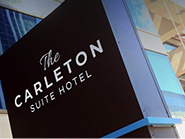If you are, you’re not alone. In fact, we’re betting you have plenty of company in trying to wrap your head around how to approach a looming rebranding project. As a branding agency, we get quite a few inquiries about possible rebranding projects. Every story is slightly different. Alarmingly, a significant number of people we talk to have no idea what a rebrand could or should involve.
What is rebranding?
At its heart rebranding is about changing the perceptions of and, feelings about your company with its most important audiences. To paraphrase Jeff Bezos, it’s trying to change what people are saying about you when you’re not in the room. It’s seldom achieved by changing a single element of your brand (like your logo) and it's rarely achieved in one fell swoop. Hey, nobody said this was going to be easy.
While we wish you the best on the rebranding journey that lies ahead, we’d like you to consider a few questions that may bring you a measure of clarity.
Why are you rebranding?
Just because your new CEO has decided that she’s tired of your logo or, your board of directors has made rebranding a strategic priority isn’t enough of a reason. You need to dig a little (or a lot) deeper to develop a compelling case for rebranding. Furthermore, you need to understand what a brand really is and the components of an effective brand. If all you plan to do is change your logo, then you’re not rebranding, you're, um, changing your logo.
What difference will a rebrand make?
Here’s the bottom line - a brand is an asset. Brands like Apple, Coca-Cola and Google are worth billions. Any rebranding project should be making a positive difference to your business or organization. It should have an impact on the bottom line or solve a vexing business problem. If your brand needs to be reworked, it also needs a business goal. From our experience, a rebranding project is usually driven by trying to solve a business problem. Do you have a business problem that a rebrand could fix? Then figure out what it is and get it on the table at the outset.
Where are you going to start with your rebranding?
Here’s a suggestion - it’s not with your logo. Start by talking to people to get their impressions and experiences with all aspects of your brand. What do they think of your brand? What do they think of your competition? How do they feel about how you treat them? How would they describe their experience with your brand? Do they understand who you are, what you do and why you matter?
We’d suggest you start with a series of discovery sessions with small groups of people in various positions and levels of your company. More importantly, we implore you to talk to people outside the company including clients, suppliers and other stakeholders. This often requires a thick skin because the answers you get may not be all sunshine and lollipops.
Who will be responsible for the rebranding?
A rebranding project of any significance requires leadership, passion, and commitment. In our experience, that seldom comes from making a committee responsible. Give the responsibility of carrying the rebranding ball to one or at the maximum, two people. Ensure that they have the support as well as the internal and external resources they need. Let them and anyone else they recruit do their jobs.
Is this a brand tune-up or an overhaul?
Rebranding doesn’t always need to be a case of throwing everything out and starting fresh. If you go to the trouble of keeping your finger on the pulse of your customers and industry a series of strategic changes may be the way to go. When Harley-Davidson turned their brand around years ago, they started with fixing their products before they did anything else.
People don’t understand who you are and what you do? Maybe it’s time to look at your brand messaging and content. Is brand awareness low? Maybe you need to examine your sales and marketing instead. High levels of customer turnover? Maybe your brand experience or, product quality needs to be looked at.
Are you willing to be different?
Branding should be about differentiating your organization or business. Sounds easy but all too often there is a tendency to produce "me-too” brands that simply mimic what somebody else is doing. That’s particularly common when a committee is micro-managing the rebranding project. Forging a different path is often seen as too risky but a brand that is unwilling to take risks in order to differentiate itself is destined to end up as a commodity, not a brand.
What’s on the rebranding table?
Is there any element of your current brand or marketing that cannot be touched? It’s best to know that going in although a rebrand of any substance should put everything on the table. We’ve seen more than one company decide to undergo a rebrand only weeks after launching a new website. Why a company would decide to rebrand weeks after launching a new (apparently untouchable) website is still a puzzler to us.
























